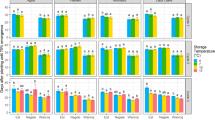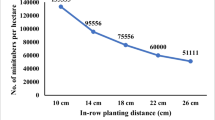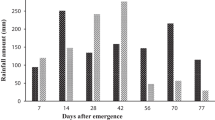Abstract
Physiological age of seed potatoes can impact stem number per plant and harvestable tuber number and size. Alteration in harvested tuber size has economic implications based upon market and pricing. The objective of this study was to manipulate physiological age of seed potatoes utilizing seven storage temperature regimes for two cultivars (Ranger Russet and Russet Burbank) over three different growing seasons in Idaho and to assess changes in stem number and harvested tuber size profile. Aged seed were planted in three locations in Idaho and evaluated for stem number per plant and yield. As seed storage temperature increased, seed physiologically aged, as evidenced by a rise in the number of stems per plant. This result was similar in all three locations and for both cultivars. The number of stems per plant can be used as an early season predictor of potato yield and size. Stem number per plant, the number of tubers and average tuber size were compared for each treatment and location. Economic returns were analyzed using ordinary least squares regressions. Economic impacts of physiological seed aging in terms of dollars per hectare for fresh and processed markets were mixed.
Resumen
La edad fisiológica de la semilla de papa puede impactar el número de tallos por planta y el número y tamaño de tubérculo cosechable. La alteración en el tamaño de tubérculo cosechado tiene implicaciones económicas basadas sobre mercado y precio. El objetivo de este estudio fue manipular la edad fisiológica de papa-semilla utilizando siete regímenes de temperatura de almacén en dos variedades (Ranger Russet y Russet Burbank) en tres diferentes ciclos de cultivo en Idaho para analizar cambios en número de tallos y perfil del tamaño de tubérculo cosechado. Se plantó semilla vieja en tres localidades en Idaho y se les evaluó el número de tallos por planta y el rendimiento. A medida que aumentaba la temperatura del almacenamiento de la semilla, ésta envejeció fisiológicamente como se evidenció con un aumento en el número de tallos por planta. Este resultado fue similar en las tres localidades y en ambas variedades. El número de tallos por planta se puede usar para predecir temprano en el ciclo el rendimiento y tamaño de la papa. Se compararon el número de tallos por planta, el número de tubérculos y su tamaño promedio para cada tratamiento y localidad. Se analizaron las ganancias usando regresiones de cuadrados mínimos ordinarios. Se mezclaron los impactos económicos de la maduración fisiológica de la semilla en términos de dólares por hectárea para mercados fresco y de proceso.
Similar content being viewed by others
Notes
Counts indicate the average number of potatoes per carton. For example, a 100 count carton would be expected to contain between 95 and 105 potatoes (Idaho Potato Commission 2016).
USDA NASS reports that yields for all potatoes in the counties in which Aberdeen, Kimberly and Parma are located (Bingham, Twin Falls, Canyon) averaged over 2006–2011 were respectively 41.3, 58.2 and 51.6 Mt. ha−1.
References
Allen, E.J., and P.J. O'Brien. 1986. The practical significance of accumulated day-degrees as a measure of physiological age of seed potato tubers. Field Crops Research 14: 141–151.
Blauer, J.M., L.O. Knowles, and N.R. Knowles. 2013. Manipulating stem number, tuber set and size distribution in specialty potato cultivars. American Journal of Potato Research 90: 470–496.
Bleasdale, J.K.A. 1965. Relationships between set characters and yield in maincrop potatoes. The Journal of Agricultural Science 64: 361–366.
Bussan, A.J., P.D. Mitchell, M.E. Copas, and M.J. Drilias. 2007. Evaluation of the effect of density on potato yield and tuber size distribution. Crop Science 47: 2462–2472.
Corsini, D., J. Stark, and M. Thornton. 1999. Factors contributing to the blackspot bruise potential of Idaho potato fields. American Journal of Potato Research 76: 221–226.
Hammes, P.S. 1985. The effect of stem population on tuber yield in a trial with single-stem seed pieces. Potato Research 28: 119–121.
Idaho Potato Commission. 2016. A size guide to America’s favorite potato. https://idahopotato.com/uploads/media/IPC-carton-count-size-guide.pdf. Last accessed May 2016.
Iritani, W.M., R. Thornton, L. Weller, and G. O'Leary. 1972. Relationships of seed size, spacing, stem numbers to yield of russet Burbank potatoes. American Journal of Potato Research 49: 463–469.
Iritani, W.M., L.D. Weller, and N.R. Knowles. 1983. Relationships between stem number, tuber set and yield of russet Burbank potatoes. American Journal of Potato Research 60: 423–431.
Knowles, N.R., and G.I. Botar. 1992. Effect of altering the physiological age of potato seed tubers in the fall on subsequent production in a short season environment. Canadian Journal of Plant Science 72: 275–287.
Knowles, N.R., and L.O. Knowles. 2006. Manipulating stem number, tuber set and yield relationships for northern- and southern-grown potato seed lots. Crop Science 46: 284–296.
Lynch, D.R., G.C. Kozub, and L.M. Kawchuk. 2001. The relationship between yield, mainstem number, and tuber number in five maincrop and two early-maturing cultivars. American Journal of Potato Research 78: 83–90.
SAS Institute, Inc. 2015. SAS 9.4 Procedures Guide. Cary, North Carolina, USA
Wurr, D.C.E. 1978. Seed production and management. In The Potato Crop, ed. P.M. Harris, 327–354. London: Chapman & Hall.
Acknowledgments
Funding for the research was provided in part by the Idaho Potato Commission, the University of Idaho Agricultural Experiment Station and USDA NIFA. The authors express appreciation to Rick Knowles for discussions leading to the development of this project, and to Gina Greenway for comments on earlier drafts.
Author information
Authors and Affiliations
Corresponding author
Rights and permissions
About this article
Cite this article
Nepal, S., McIntosh, C.S., Thornton, M.K. et al. Manipulation of Physiological Seed Age of Russet Burbank and Ranger Russet Potatoes – Economic Evaluation. Am. J. Potato Res. 93, 590–601 (2016). https://doi.org/10.1007/s12230-016-9539-z
Published:
Issue Date:
DOI: https://doi.org/10.1007/s12230-016-9539-z




